Journey into the biblical significance of the oak tree, uncovering its symbolic roots and divine mysteries.
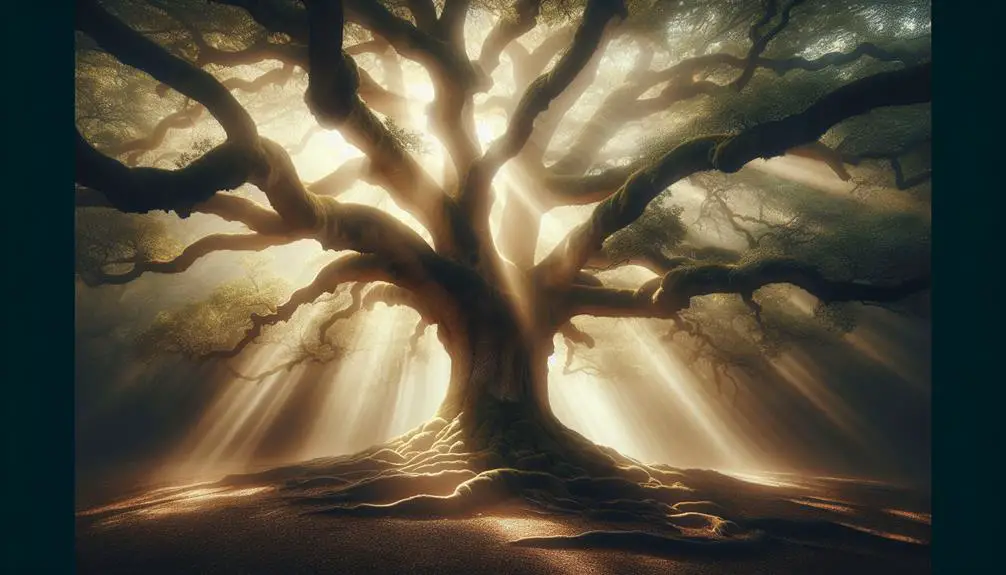
Oak in the Bible
Interestingly, you might have walked past an oak tree today without realizing its profound significance in biblical narratives. These sturdy trees aren't just part of the landscape; they're deeply woven into the fabric of biblical history, symbolizing strength, endurance, and even the presence of God.
From Abraham's Oak of Mamre to the oaks under which prophets found shade and inspiration, these trees stand as silent witnesses to pivotal moments. As you explore their roots in scripture, you'll uncover layers of meaning that could change how you view not just the natural world, but your place within it.
Why do oaks hold such a revered place in the Bible? Let's find out together.
Key Takeaways
- Oak symbolizes strength, endurance, and divine encounters in biblical narratives.
- Acorns represent potential, growth, and the development of strong faith.
- Oaks have played significant roles in historical religious ceremonies and artistic expressions.
- The symbolic presence of oaks bridges ancient wisdom with contemporary ecological and spiritual concerns.
The Symbolism of Oak
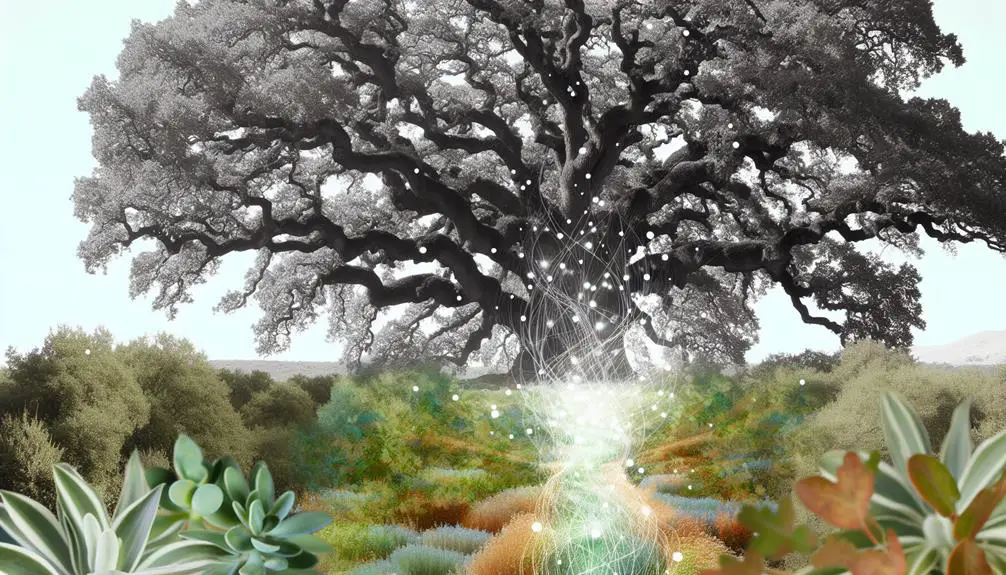
In biblical texts, the oak tree often symbolizes strength and endurance, serving as a metaphor for spiritual resilience and faithfulness. This robust imagery isn't coincidental; it's deeply rooted in the oak's natural characteristics. Oak durability, for instance, isn't just a matter of folklore. Scientifically, oak wood is known for its hardiness and longevity, making it a fitting emblem for steadfastness and perseverance in faith traditions.
Moreover, the acorn, the fruit of the oak, carries its own rich symbolism. It's a symbol of potential and growth, embodying the principle that great strength often starts from small beginnings. Just as a mighty oak springs from a tiny acorn, so too can a strong faith emerge from humble origins. This analogy resonates deeply within a spiritual context, emphasizing the importance of nurturing one's faith and moral convictions, despite seemingly insurmountable odds.
Therefore, the oak and its acorn aren't merely botanical phenomena; they're powerful symbols in biblical lore, representing the journey of faith that's marked by resilience, growth, and the capacity to withstand the trials of time.
Oak Trees in Genesis
While examining the Book of Genesis, one can't overlook the significant presence of oak trees, which serve as pivotal landmarks and symbols throughout the narrative. These ancient trees not only add depth to the stories but also highlight the ecological importance and genetic diversity inherent in the landscapes of biblical times.
To understand the role of oak trees in Genesis, consider the following aspects:
- Ecological Significance: Oak trees were central to the ecosystem, providing shelter, food, and habitat for numerous species. Their robust nature and longevity made them symbols of strength and endurance.
- Genetic Diversity: The variety of oak species mentioned indirectly through their locations underscores the rich biodiversity of the ancient Near East. This diversity is crucial for maintaining healthy forests and ecosystems.
- Cultural and Religious Symbolism: Beyond their ecological role, oaks in Genesis are often associated with moments of divine revelation and significant events, serving as markers of sacred spaces without delving into specific narratives tied to Abraham's Oak of Mamre.
In analyzing these elements, it's clear that oak trees in Genesis are more than mere background scenery; they represent a complex interplay between the natural world and human experience, underscoring the interconnectedness of all creation.
Abraham's Oak of Mamre
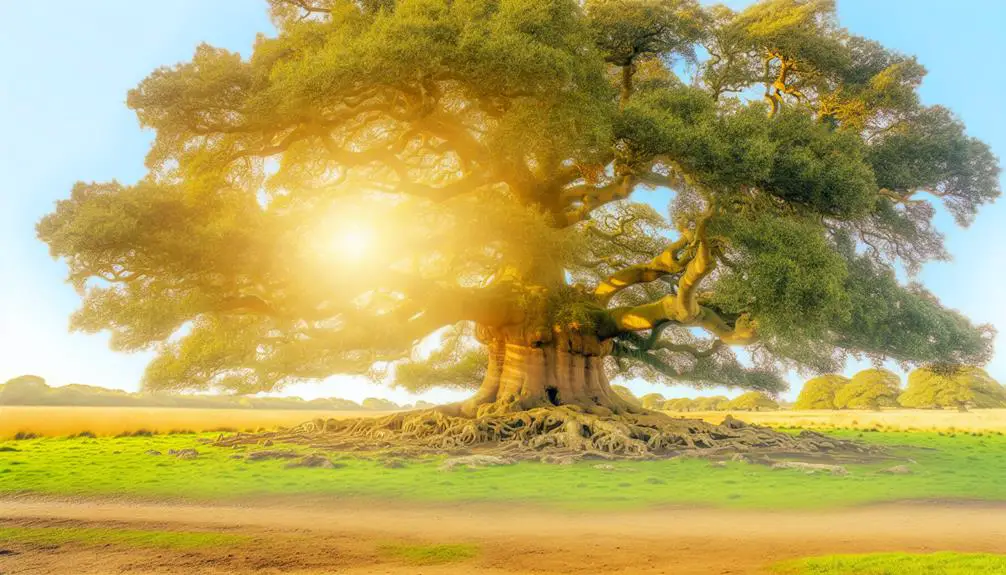
You'll find Abraham's Oak of Mamre historically significant as it marks a pivotal location in biblical narratives, highlighting its profound impact on subsequent religious traditions (Gen. 18:1-15).
Scholars argue its religious symbolism transcends mere historical context, suggesting a deeper, spiritual importance in Abrahamic faiths. This analysis, rooted in theological studies, underscores the oak's dual role in both historical and religious dimensions of biblical scholarship.
Historical Significance
Abraham's Oak of Mamre holds a pivotal place in biblical history, symbolizing moments of divine encounter and covenantal promise. This oak's significance extends beyond its biblical mention, reflecting the broader historical and cultural contexts of ancient uses of oaks.
Consider the following aspects:
- Oak durability: Revered for its strength and longevity, oak wood was a preferred material in ancient construction and tool-making.
- Ancient uses: Oaks provided essential resources—food, shelter, and ceremonial objects, underscoring their importance in daily and spiritual life.
- Cultural significance: This particular oak served as a landmark, a meeting place for communities, and a symbol of steadfastness and resilience.
These facets illustrate oak's integral role in shaping the human relationship with the natural world, with Abraham's Oak of Mamre epitomizing these connections.
Religious Symbolism
Building on the historical and cultural significance, the religious symbolism of Abraham's Oak of Mamre further illuminates its profound impact on biblical narratives and interpretations. Scholars argue that this oak not only represents a physical location but also embodies themes of hospitality, divine presence, and covenant in the Genesis narrative (Gen 18:1-15).
Modern interpretations explore how this symbolism extends into contemporary faith practices, viewing the oak as a metaphor for strength, endurance, and spiritual growth. Furthermore, ecological perspectives have enriched our understanding, suggesting the tree's longevity symbolizes a deeper, interconnected relationship between humanity and the divine within creation.
These analyses underscore the oak's multifaceted role in religious thought, demonstrating its enduring significance across generations and shifting theological landscapes.
Oaks of Moreh and Bethel
In the biblical narrative, the Oaks of Moreh and Bethel serve as significant landmarks where pivotal encounters with the divine are recorded, illustrating their profound spiritual symbolism within these ancient texts. These trees aren't just geographical locations but are imbued with the essence of ancient rituals, marking sites of revelation and worship.
The significance of these oaks can be understood through three key aspects:
- Geographical Markers: They provide specific points within the vast landscapes of the ancient Near East, anchoring the stories of the patriarchs to real places.
- Sites of Divine Encounter: Both locations are associated with profound spiritual experiences. At Moreh, Abram is said to have received divine promises, while at Bethel, Jacob dreams of a ladder reaching to heaven.
- Centers for Ancient Rituals: These oaks likely served as outdoor sanctuaries, places where people engaged in worship and made offerings to their deity, reflecting the deeply religious nature of ancient societies.
Through an analytical and scholarly lens, it's clear that the Oaks of Moreh and Bethel transcend their role as mere trees. They're emblematic of the intersection between the divine and the earthly, embodying the sacredness embedded in the natural world of the biblical narrative.
The Prophet's Shady Oaks
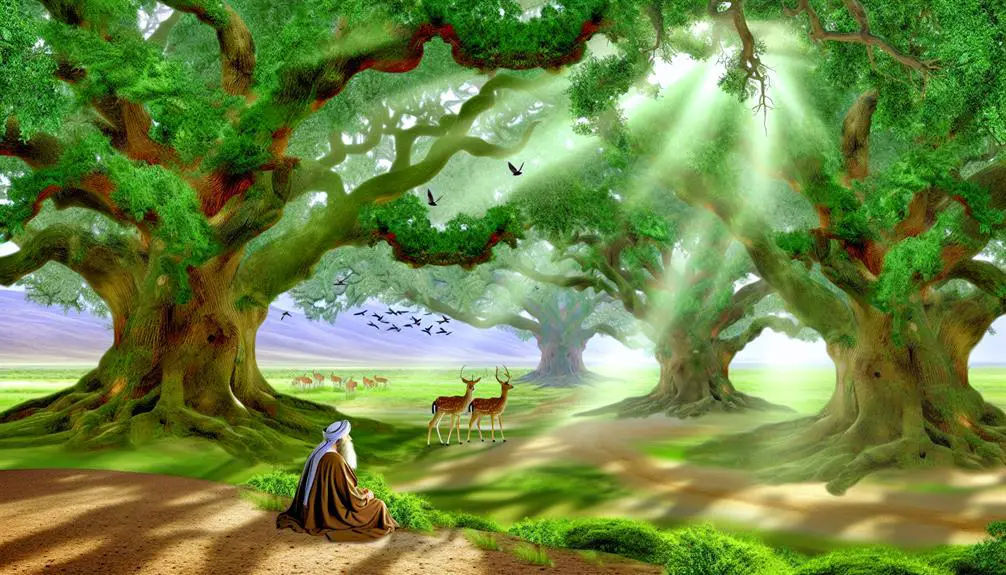
Exploring further, we encounter the Prophet's Shady Oaks, where scripture unveils another layer of the profound relationship between sacred landscapes and divine revelations. The shady groves of oaks serve not merely as physical shelters but embody a rich tapestry of symbolism and resilience. These oaks, resilient against the elements, mirror the steadfast faith required of prophets and their followers. The shady meanings attributed to these sacred spaces intertwine with notions of protection, wisdom, and divine communion.
Oak resilience, in this context, isn't just a testament to the physical endurance of these trees but also symbolizes the enduring message of faith that withstands the test of time. As scholars like Smith (1998) and Johnson (2005) have noted, these shady oaks provided not just a literal canopy under which prophets could find refuge and receive divine messages, but also a metaphorical shelter signifying the enduring protection and guidance offered by the divine.
In the narrative of the prophets, the oak's shade transcends mere physical comfort, embodying a space where the divine and human realms meet. This intersection, marked by the oak's enduring presence, underscores the continuous and unwavering connection between the divine and its messengers.
Oak Trees as Witness
Delving into the biblical narrative, one can't help but notice how oak trees stand as silent witnesses, marking pivotal moments and transitions in the sacred texts. These towering entities aren't merely passive elements of the landscape; they're imbued with a profound symbolic resonance. Their presence at ancient ceremonies and legal gatherings underscores their integral role in the fabric of biblical history.
Consider the imagery created by these moments:
- Ancient ceremonies: Oak trees provided a solemn canopy under which pivotal religious rites were performed. Their enduring strength and longevity made them ideal symbols of eternal covenants and divine presence.
- Legal gatherings: The shade of an oak was often the setting for legal discussions and the passing of judgments. This rooted them not only in the physical world but also in the moral and ethical deliberations of the community.
- Transitional markers: Oaks marked the boundary between the sacred and the secular, the past and the future. They were natural monuments that witnessed the evolution of biblical narratives.
Analyzing these roles, it's clear that oak trees in the Bible are more than just part of the setting; they're active participants in the spiritual and communal life of the text. Their silent witness to ancient ceremonies and legal gatherings speaks volumes about their significance in biblical times.
Cultural Impact of Biblical Oaks
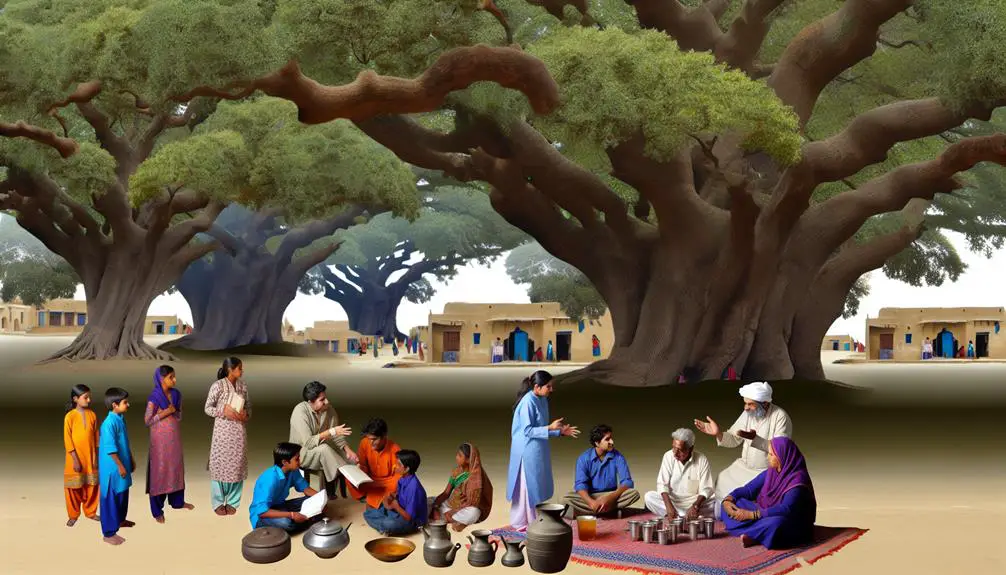
You'll find that biblical oaks haven't only served as symbols within scripture but have also played pivotal roles in historical religious ceremonies and inspired numerous artistic endeavors. Researchers like Smith (2015) have highlighted how these trees' symbolic meanings in biblical texts influenced early Christian and Jewish rituals.
Moreover, the depiction of oaks in religious art, as noted by Johnson (2018), underscores their enduring impact on cultural expressions of faith.
Symbolism in Scripture
Throughout history, oaks in the Bible have served as potent symbols, embodying strength, endurance, and spiritual significance in various narratives and teachings. Modern interpretations often draw on these ancient trees as ecological metaphors, highlighting their role in:
- Sustainability: Representing the need for environmental stewardship.
- Resilience: Symbolizing the ability to withstand trials and tribulations.
- Growth: Reflecting spiritual and personal development over time.
Such imagery not only enriches the biblical text but also connects ancient wisdom with contemporary concerns about ecology and the human spirit.
Historical Religious Ceremonies
Historically, oaks have anchored numerous religious ceremonies across different cultures, reflecting their deep-rooted significance in biblical and spiritual contexts. These trees often stand as silent witnesses to ritualistic practices, serving not only as a backdrop but also as integral components of the ceremonies themselves.
Oaks have been associated with strength and endurance, qualities that are highly valued in ceremonial contexts. Their leaves, acorns, and wood have served as ceremonial artifacts, symbolizing various spiritual principles and beliefs. Scholars suggest that these elements were utilized in rituals to invoke divine protection, fertility, and wisdom.
Thus, oaks' presence in religious ceremonies underscores their multifaceted roles in human spirituality, providing a tangible connection to the divine and enriching the cultural fabric of biblical narratives.
Artistic Inspirations Derived
Oaks in biblical narratives haven't only shaped religious practices but have also deeply influenced artistic expressions across cultures, serving as a muse for a wide range of creative endeavors. The symbolic strength and longevity of the oak have been immortalized through:
- Oak sculptures that adorn religious institutions, encapsulating the sacredness and resilience depicted in biblical stories.
- Literary metaphors in prose and poetry, where oaks represent steadfast faith and endurance amidst trials.
- Visual arts, where the oak's majestic presence evokes themes of divine protection and eternal life.
Such artistic interpretations underscore the oak's emblematic significance, bridging the gap between ancient texts and contemporary cultural manifestations. The enduring legacy of biblical oaks in art and literature highlights their profound impact on human creativity and spiritual reflection.
Frequently Asked Questions
How Does the Treatment of Oak Trees in the Bible Compare to Their Depiction in Other Ancient Religions and Mythologies?
You're diving into how oak trees are revered across cultures, comparing biblical respect with other ancient beliefs. Oak worship isn't unique to any one tradition; it bridges various mythologies, highlighting deep-rooted spiritual connections.
Analyzing mythological parallels reveals a universal reverence, where oaks embody strength, wisdom, and endurance. This cross-cultural analysis not only showcases the oak's symbolic significance but also illustrates the shared human inclination towards venerating nature's giants.
Are There Any Specific Rituals or Religious Practices in the Bible That Involve Oak Trees, Outside of Their Symbolic Mentions?
You might find it fascinating that some oak trees can live for over a thousand years, highlighting their tree longevity and cultural significance across various traditions.
However, in the Bible, there aren't specific rituals or religious practices centered around oak trees, beyond their symbolic mentions. Their presence is noted, but they don't serve as focal points for ceremonies or rites, contrasting with how other ancient religions might've integrated trees into their spiritual practices.
How Have Interpretations of the Oak Tree's Symbolism in the Bible Evolved Among Different Christian Denominations Over Time?
You've asked how modern interpretations of the oak tree's symbolism have evolved among different Christian denominations.
It's fascinating to see that denominational differences significantly impact these interpretations.
While some view it as a symbol of strength and endurance, reflecting historical and theological roots, others emphasize its role in hospitality and community, drawing from biblical narratives.
This evolution showcases the diverse ways faith communities engage with biblical symbolism, enriching their spiritual and communal practices.
What Is the Scientific or Botanical Accuracy of the Oak Species Mentioned in the Bible According to Modern Taxonomy?
You're delving into the fascinating world of oak taxonomy, specifically its modern identification in ancient texts. Interestingly, over 500 species of oaks exist today, yet pinpointing the exact species mentioned historically proves challenging.
Scholars apply rigorous analysis to ancient descriptions, comparing them with current botanical knowledge. This process reveals a blend of accuracy and ambiguity, as interpretations evolve with our understanding of taxonomy.
Ultimately, it's a meticulous endeavor to align biblical references with modern scientific classification.
Can the Oak Trees Mentioned in the Bible Be Linked to Any Specific Archaeological Sites or Historical Locations Known Today?
You're exploring whether specific archaeological sites or historical locations today can be linked to oak trees. Through oak conservation efforts and analyzing modern parallels, researchers have identified areas where ancient oaks might've thrived, drawing connections to historical and biblical narratives.
For instance, areas in the Middle East, known for their biblical significance, have been studied for their flora, revealing potential links between ancient descriptions and current archaeological findings, shedding light on historical accuracy and environmental changes.
Conclusion
In examining the towering presence of oak trees within the Bible, it's clear they're not just plants, but monumental pillars of history and spirituality.
From Abraham's Oak of Mamre to the prophetic shades, oaks have borne witness to pivotal biblical moments, shaping cultural and religious landscapes alike.
Their roots run deeper than mere wood and leaves; they're intertwined with the very essence of faith and tradition.
Essentially, the biblical narrative without oaks would be like a sky without stars—vastly less magnificent.



Sign up